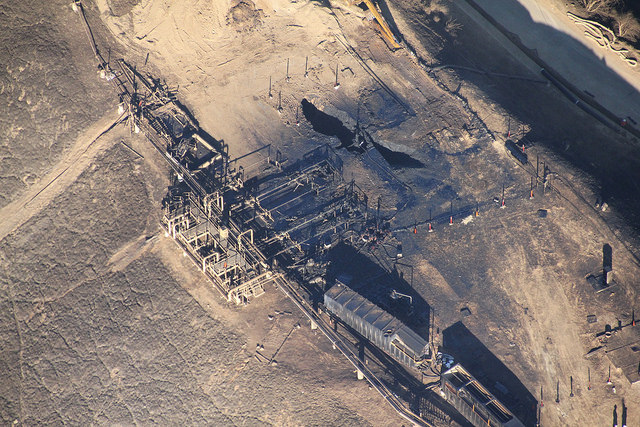
Porter Ranch Response from the Capitol
LED: Emerging from the Shadow of Incandescent Lighting
Planning for Cleaner Freight Moving Forward
 Porter Ranch Response from the Capitol
Porter Ranch Response from the Capitol
By Kathryn Phillips
(Photo credit: Earthworks)
Since their return to work in Sacramento in early January, legislators have been preparing legislation in response to the massive Aliso Canyon methane gas leak near Porter Ranch in northern Los Angeles County.
The Aliso Canyon leak has been in progress since October 23 and has displaced thousands of people from their homes in and near the Porter Ranch Community. The Governor declared a state of emergency January 6. Recently the South Coast AQMD, the Los Angeles County District Attorney, and the State Attorney General have filed lawsuits against the owner of the storage facility, Southern California Gas Company.
So far, legislators have introduced three bills specifically tied to that leak, and more may surface before the February 19 deadline for bill introductions. The Aliso Canyon methane storage facility is just one of 13 such facilities around the state.
One of those bills, SB 380, by Senator Fran Pavley, would impose an immediate moratorium on injecting natural gas into any well at the Aliso Canyon storage facility until a whole lot of inspection and fixing has occurred. It adds other requirements for restarting old wells there, and it requires the Public Utilities Commission to study the feasibility of eliminating that entire gas storage facility.
That bill was pushed through the Senate with the help of an urgency clause shortly after being introduced and is preparing to go through the Assembly committee process. Two other bills, SB 888 by Senator Ben Allen, and SB 887, by Senator Pavley, address how to monitor and inspect gas facilities, upgrade safety equipment, and better coordinate emergency responses to gas leaks. Those bills will begin their travels through Senate committees in a few weeks.
Meanwhile, on February 4, the California Air Resources Board held a workshop on a new draft of oil and gas regulations for controlling air pollution. The new draft began to address some of the issues raised by the Aliso Canyon leak, but agency staff told workshop attendees that they are continuing to work on additional regulatory proposals that respond to issues raised by the Aliso Canyon leak.
And on February 5th as we put this newsletter issue to bed, the Division of Oil, Gas and Geothermal Resources issued new emergency regulations to respond to the Governor's emergency declaration.
The leak is buried deep underground and Southern California Gas crews are working to reach it and repair it. The exact cause of the leak is still not certain, but the leaking pipe did not contain an automatic shut-off valve that could have gone into action to stop emissions as soon as they were discovered.
 LED: Emerging from the Shadow of Incandescent Lighting
LED: Emerging from the Shadow of Incandescent Lighting
By Edward Moreno
We’ve enjoyed the warm glow of incandescent light bulbs since the 1880’s, when the technology became accessible to the general public. Now the state has been mandated to phase out the incandescent light bulb by 2018, bringing its 138-year reign to an end.
But fear not, the warm full-spectrum lighting that we have grown to love will not be lost. The California Energy Commission (CEC) just adopted efficiency standards for general service LED light bulbs. These standards are the first of this kind in the nation.
By 2029, the new efficiency standards will provide an opportunity for Californians to save up to $4 billion and about 3,000 GwH per year, which is equivalent to avoiding the construction of one 500 MW power plant. As a result, California will avoid 10.3 million metric tons of CO2 or the emissions of about 168,000 cars.
But what sets these standards apart from the rest, is the focus on color quality. The new regulations set a color quality standard, which assures that when you replace old light bulbs with a new LED light bulb that you will continue to enjoy the beautiful colors of a Diego Rivera painting in your living room because the standard requires full-spectrum color quality, which is lost with compact fluorescence lighting or older LED technology.
Opponents of the proposal claim that consumers did not care about color quality and complained that the CEC standard was unnecessary.
However, Sierra Club California and its members shattered the opponents’ argument by submitting over 1600 comments emphasizing that color quality is important to consumers and that the CEC should stay strong on its proposal. In the end the commission adopted the new LED lighting standards unanimously, putting the state one step closer to meeting California’s climate goals.
This was a big win for energy efficiency, and just the first of many efficiency regulations the commission is pursuing over the next two years. Next up: computers, monitors and displays.
Join the fight to keep California a world leader in energy efficiency. Sign up for our opt-in list to stay informed about upcoming energy efficiency standards and receive alerts for action.
 Planning for Cleaner Freight Moving Forward
Planning for Cleaner Freight Moving Forward
By Diana Vazquez
We all enjoy the convenience of fully stocked shelves of wine, or fresh fruit in the produce section of grocery stores. But we often don’t consider that getting those products to market may be negatively impacting the air we breathe.
California's freight transportation system is responsible for one-third of the State's economy and jobs. However it is also responsible for emitting a high portion of local toxics and criteria pollutants, and accounts for about half of toxic diesel particulate matter (diesel PM), 45 percent of the emissions of nitrogen oxides (NOx) that form ozone and fine particulate matter in the atmosphere. These pollutants impact the health and well-being of all Californians.
As a way to help transform California’s freight transportation system into a cleaner one, Governor Brown issued Executive Order B-32-15 in July 2015 directing the California Air Resources Board, the California Department of Transportation, the California Energy Commission, and the Governor’s Office of Business and Economic Development (GO-Biz) to create a California Sustainable Freight Action Plan (Action Plan).
So far, the agencies have produced an outline of issues to be included in the action plan. Among those are freight efficiency, transitioning to zero-emission technologies, and increasing competitiveness of California’s freight system. The outline also identifies State policies, programs, and investments to achieve these targets.
The agencies recently held a series of workshops (in which Sierra Club California staff and volunteers participated) to gather comment. Within the next month, a draft action plan is expected to be released.
Club staff and members are strongly advocating for commitment to zero-emission vehicles within the freight sector, and assurances that any new infrastructure development for moving freight results in reduced pollution.
You can learn more about the agencies at the California Air Resources Board’s page on the Sustainable Freight Transportation Initiative. If you would like to participate in Sierra Club California advocacy on this issue, contact me, Diana Vazquez, at diana.vazquez@sierraclub.org.
Follow Us:
  |
Thank you for being a part of our work! You may securely donate online or by sending a check to Sierra Club California at 909 12th Street, Suite 202, Sacramento, CA 95814.
